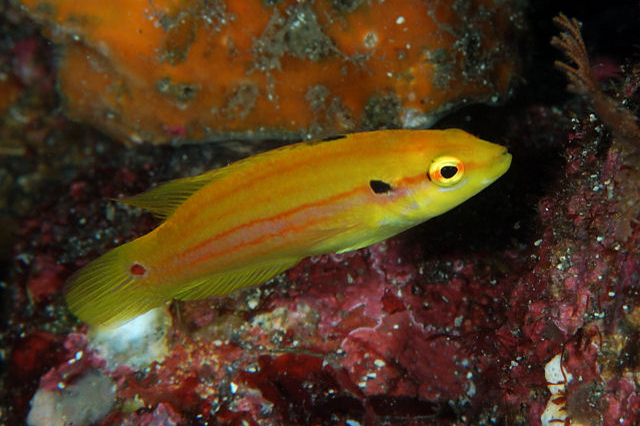- Classification
- ACTINOPTERYGII
- PERCIFORMES
- LABRIDAE
- Bodianus
- bimaculatus
Twospot Pigfish, Bodianus bimaculatus Allen 1973
Other Names: Twospot Hogfish

A Twospot Pigfish, Bodianus bimaculatus, at Izu Ocean Park, japan. Source: Izuzuki / http://www.izuzuki.com/. License: CC by Attribution-NonCommercial-ShareAlike
Summary:
Males of this small pigfish are pinkish with narrow red stripes. Small juveniles are bright yellow, and females become more orange as the red stripes develop.
Cite this page as:
Bray, D.J. 2022, Bodianus bimaculatus in Fishes of Australia, accessed 25 Apr 2024, https://fishesofaustralia.net.au/Home/species/1226
Twospot Pigfish, Bodianus bimaculatus Allen 1973
More Info
|
Distribution |
Northwest Shelf to Scott Reef, Western Australia, and the northern Great Barrier Reef, Queensland and reefs in the Coral Sea, to off Crowdy Head, New South Wales. Elsewhere, the species is widespread in the Indo-Pacific from Madagascar to Vanuatu and New Caledonia, north to Japan, and south to New Zealand. Adults often inhabit rubble and sandy areas on steep outer reef slopes and drop-offs, usually near very deep water. Forms small harems in soft bottom habitats with sponges and soft corals. |
|
Features |
Dorsal fin XII, 9-10; Anal fin III, 11-12. |
|
Biology |
Protogynous hermaphrodites with a large dominant male forming a harem comprising juveniles and females. |
|
Etymology |
The specific name bimaculatus is from the Latin bi- (= two, twice), and macula (=spot), in reference to the characteristic black spots on the opercleum and caudal peduncle of this species. |
|
Species Citation |
Bodianus bimaculatus Allen, 1973, Proc. Biol. Soc. Washington 86(32): 385, fig. 1. Type locality: Vertical dropoff at Bairakaseru Island, Ngemelis Islands, Palau Archipelago, Philippine Sea, depth 42 m. |
|
Author |
Bray, D.J. 2022 |
|
Resources |
Twospot Pigfish, Bodianus bimaculatus Allen 1973
References
Allen, G.R. 1973. Bodianus bimaculatus, a new species of wrasse (Pisces : Labridae) from the Palau Archipelago. Proceedings of the Biological Society of Washington 86(32): 385-390 fig. 1 See ref at BHL
Allen, G.R. 1997. Marine Fishes of Tropical Australia and South-east Asia. Perth : Western Australian Museum 292 pp. 106 pls.
Allen, G.R. & Erdmann, M.V. 2012. Reef fishes of the East Indies. Perth : Tropical Reef Research 3 vols, 1260 pp.
Fricke, R., Earle, J., Pyle, R.L. & Seret, B. 2011. Checklist of the fishes. pp. 343-409 in Bouchet, P., Le Guyader, H. & Pascal, O. (eds) 2011. The Natural History of Santo. Muséum national d'Histoire naturelle, Paris, IRD, Marseille, Pro-Natura international, Paris, 572 pp.
Gomon, M.F. 2006. A revision of the labrid fish genus Bodianus with descriptions of eight new species. Records of the Australian Museum Supplement 30: 1-133. https://doi.org/10.3853/j.0812-7387.30.2006.1460
Kuiter, R.H. 2010. Labridae fishes: wrasses. Seaford, Victoria, Australia : Aquatic Photographics 398 pp.
Kuiter, R.H. & Tonozuka, T. 2001. Pictorial guide to Indonesian reef fishes. Part 2. Fusiliers - Dragonets, Caesionidae - Callionymidae. Australia : Zoonetics pp. 304-622.
Randall, J.E., Allen, G.R. & Steene, R. 1990. Fishes of the Great Barrier Reef and Coral Sea. Bathurst : Crawford House Press 507 pp. figs.
Randall, J.E., Allen, G.R. & Steene, R. 1997. Fishes of the Great Barrier Reef and Coral Sea. Bathurst : Crawford House Press 557 pp. figs.
Randall, J.E., Myers, R.F., Trevor, M.N., Johnson, S.R., Johnson, J.L., Yoshi, Y. & Greene, B.D. 2005. Ninety-one new records of fishes from the Marshall Islands. aqua, Journal of Ichthyology and Aquatic Biology 9(3): 115-132
Russell, B. & Myers, R. 2010. Bodianus bimaculatus. The IUCN Red List of Threatened Species 2010: e.T187638A8586982. https://dx.doi.org/10.2305/IUCN.UK.2010-4.RLTS.T187638A8586982.en. Accessed on 29 March 2022.
Westneat, M.W. 2001. Labridae. pp. 3381-3467 in Carpenter, K.E. & Niem, T.H. (eds). The Living Marine Resources of the Western Central Pacific. FAO Species Identification Guide for Fisheries Purposes. Rome : FAO Vol. 6 pp. 3381-4218.








